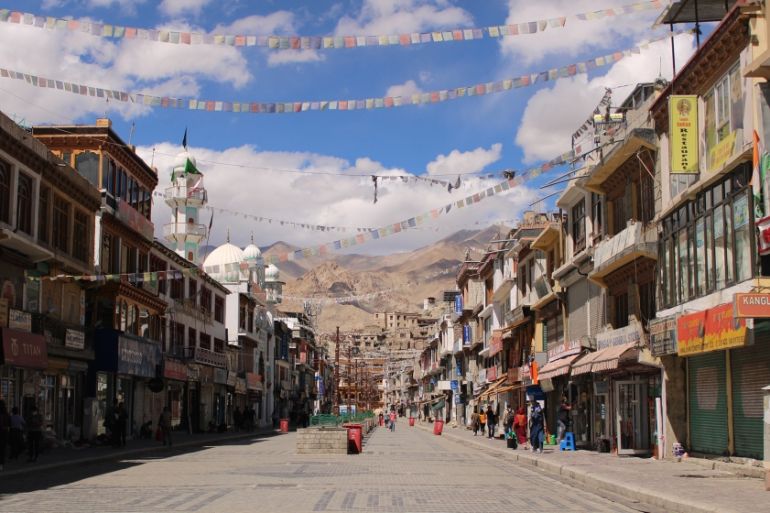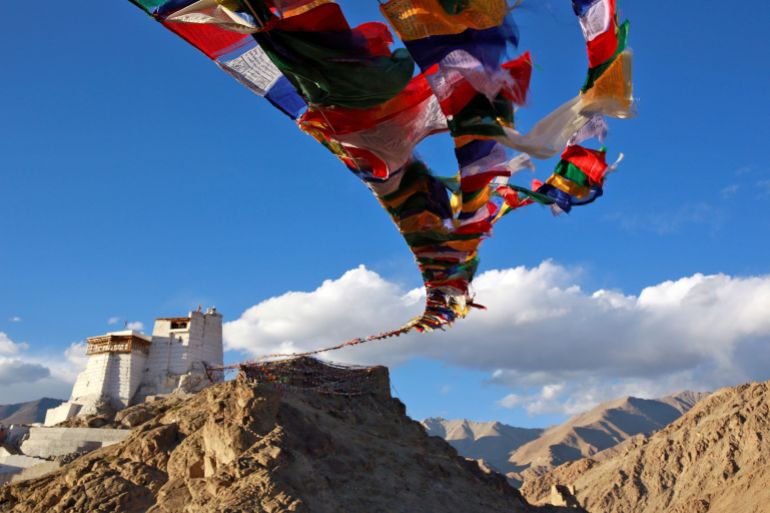Why India’s Ladakh is witnessing growing discontent
Unprecedented shutdown earlier this week in the strategic Himalayan region underscores its demand for more autonomy.

Srinagar, Indian-administered Kashmir – Earlier this week, the region of Ladakh, a Himalayan desert in Indian-administered Kashmir that borders China and Pakistan, witnessed an unprecedented shutdown to demand statehood and protection of land and jobs.
The rare strike held on Monday was jointly called by two groups based in the two districts of Ladakh: the Apex Body of Leh and the Kargil Democratic Alliance, both campaigning for the residents’ rights in the tribal-dominated region and preservation of their cultural identity.
Keep reading
list of 4 itemsAs India takes direct control of Ladakh, locals wary of outsiders
Jammu and Kashmir: Hope and concerns in Ladakh
In Pictures: India’s tunnel project to link Kashmir with Ladakh
The two groups were formed after New Delhi in 2019 unilaterally scrapped the special status of Indian-administered Kashmir and divided the disputed region – also claimed in its entirety by Pakistan – into two federally governed territories: Jammu and Kashmir, and Ladakh.
On August 5, 2019, Prime Minister Narendra Modi’s right-wing government abrogated Articles 370 and 35A of the Indian constitution, legislation that had provided Indian-administered Kashmir with a degree of autonomy and denied property rights to outsiders from other Indian states.
Ladakh is home to nearly 300,000 people living in its two districts: the main city of Leh which is predominantly Buddhist, and Muslim-majority Kargil. Situated at an altitude of 5,730 metres (18,799 feet) above sea level, 97 percent of the region’s population is tribal.
And for the first time in decades, the two Ladakh districts are on the same page in pressing the government for their demands for statehood and protection of rights.
New Delhi’s controversial 2019 move was immediately rejected by most residents in Kargil, who wanted to remain with Indian-administered Kashmir, home to nearly 13 million people, more than 68 percent of them Muslim, according to a 2011 census.
Nearly seven million of those people live in the Kashmir Valley, where 97 percent of the residents are Muslim and which has been a hotbed of rebellion against Indian rule for decades.
Constitutional safeguards
In Leh, however, the Modi government’s 2019 decision was initially received with jubilation and hope. Buddhist and other non-Muslim communities in the district had long been demanding a separate status, alleging discrimination by politicians and bureaucrats from the Muslim-majority valley region of Indian-administered Kashmir.
But that initial euphoria soon gave way to anger and uncertainty over fears of losing land, livelihoods and the cultural identity of the Himalayan region. As a result, both Kargil and Leh regions are now seeking more constitutional safeguards, including statehood, with an elected legislature empowered to make laws for its people.
On Tuesday, a day after the shutdown in Ladakh, its Member of Parliament Jamyang Tsering Namgyal, who belongs to Modi’s Bharatiya Janata Party (BJP), raised the issue in parliament, demanding the safeguards provided by the Sixth Schedule of India’s constitution, which allows for greater political autonomy in the tribal-dominated areas in India’s northeast.
“I urge the government to amend the Ladakh Hill Development Council Act, passed in 1997. It needs to be defined what will be the role and responsibility of the central government, the Union Territory administration and the Lieutenant-Governor,” Namgyal said.

Ladakh residents say the fear of losing their distinct identity is more “prevalent than ever”.
“Generally, people are seeking some kind of constitutional safeguards with regard to land, employment, environment and cultural identity,” Tashi Gyalson of the Ladakh Autonomous Hill Development Council (LAHDC), an elected body that governs the region, told Al Jazeera.
When Indian-administered Kashmir was a state before August 2019, the LAHDC enjoyed significant autonomy because the elected legislature, based far away in Srinagar and Jammu cities, did not interfere much in its affairs. But with Ladakh now under the direct rule of New Delhi, the LAHDC has alleged undue influence and interference by federal administrators.
Sajjad Kargili, an activist from Kargil who is also a member of the Kargil Democratic Alliance, told Al Jazeera that after the scrapping of Article 370, the “region has lost its representation”.
“[…] We have been totally disempowered. You know, people from Pakistan-administered Gilgit and Baltistan used to give our example that we were empowered. But now, unfortunately, we are more disempowered than them,” he said.
He said they will continue to “protest peacefully and democratically” until their demands are met.
In November 2019, Ladakh-based innovator and Ramon Magsaysay and Rolex Awards winner Sonam Wangchuk created a storm when he released a video questioning the move to make Ladakh a federal territory.
In the video, Wangchuk said people in Ladakh had started asking whether the status of a “Union Territory” was granted to exploit the vast resources of Ladakh. He also said people were now fearing that India’s moves in the region were akin to China’s in Tibet.
Ladakh residents say life is not the same any more. “There is no job protection. A lot of contractual jobs have gone to people from outside. People are genuinely scared that we will soon become a minority in our own land,” Rinchen, a hotelier in Leh, told Al Jazeera.
Strategic importance
The Ladakh region sits on a razor’s edge, sharing its borders with nuclear-armed Pakistan and China. India and Pakistan fought a limited war in Ladakh’s Kargil region in 1999.
India and China share a 3,500km (2,100-mile) unmarked border through the Himalayas, but an uneasy peace has held since the two countries signed a truce following a war in 1962.
Since that war, China has been controlling the Himalayan area of Aksai Chin, which India claims is a part of the Leh district.
On August 6, 2019, a day after New Delhi scrapped the special status of Indian-administered Kashmir, Chinese foreign ministry spokesman Hua Chunying had said: “The recent unilateral revision of domestic laws by the Indian side continues to undermine China’s territorial sovereignty, which is unacceptable and will not have any effect.”
On June 15 last year, deadly clashes between Indian and Chinese soldiers erupted in Ladakh’s Galwan Valley. At least 20 Indian and four Chinese soldiers died in rare hand-to-hand combat involving clubs and rocks.
Since then, thousands of soldiers have been deployed on both sides of the de facto border, the Line of Actual Control (LAC), with experts concerned the tensions could lead to an unintentional war. Both India and China have been building infrastructure at breakneck speed near the LAC as several rounds of talks between their militaries failed to ease the tensions.
Ladakh is both geographically and politically distant from Muslim-majority Kashmir Valley where widespread anti-India sentiment gave birth to an armed rebellion three decades ago.
As the valley remained restive, a peaceful Ladakh saw tourism flourishing as the main pillar of its economy.
Jigmet Paljor, 27, a student activist from Leh who is also a member of the Apex Body of Leh, said their demands already sent to India’s home ministry are being “deliberately delayed”.
“Earlier, we had Article 370 with safeguards, but when we were given the Union Territory, it was without [elected] legislature. The other local elected representatives have no power. People fear what will happen to our jobs? What will happen to our land?” he asked.
“Our population is less. Our environment is fragile. Our culture is very distinct. The safeguards are very important to us.”
Siddiq Wahid, a political analyst based in Indian-administered Kashmir, told Al Jazeera the people in Ladakh feel “endangered as a culture”.
“Ladakhis in Leh and Kargil have united after more than 40 years because they realise that they have lost their political autonomy,” he said, adding that the residents are now protesting “because they feel duped, two years after being promised greater self-rule”.
“They are under a more centralised control than they have ever been in their modern history,” Wahid said. “The resentment is just a beginning.”